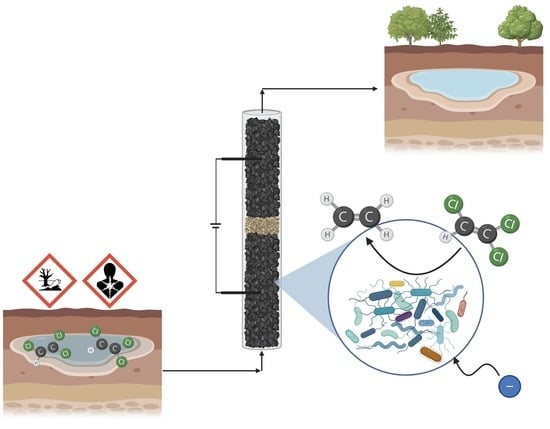Groundwater Bioremediation through Reductive Dechlorination in a Permeable Bioelectrochemical Reactor
Abstract
1. Introduction
2. Results and Discussion
2.1. Groundwater Sampling and Characterisation
2.2. Fluid Dynamic Characterisation and Preliminary Abiotic Tests
2.3. Synthetic Groundwater Laboratory Test
3. Material and Methods
3.1. Bioelectrochemical Membrane-Less PBR-like Reactor
3.2. Bioelectrochemical Reactor Operating Conditions
3.3. Analytical Procedures
3.4. Data Elaboration
4. Conclusions
Author Contributions
Funding
Data Availability Statement
Acknowledgments
Conflicts of Interest
References
- Bradley, P.M. History and Ecology of Chloroethene Biodegradation: A Review. Bioremediation J. 2003, 7, 81–109. [Google Scholar] [CrossRef]
- Moran, M.J.; Zogorski, J.S.; Squillace, P.J. Chlorinated Solvents in Groundwater of the United States. Environ. Sci. Technol. 2007, 41, 74–81. [Google Scholar] [CrossRef] [PubMed]
- McCarty, P.L. Groundwater Contamination by Chlorinated Solvents: History, Remediation Technologies and Strategies. In In Situ Remediation of Chlorinated Solvent Plumes; Stroo, H.F., Ward, C.H., Eds.; Springer: New York, NY, USA, 2010; pp. 1–28. [Google Scholar] [CrossRef]
- Jugder, B.-E.; Ertan, H.; Bohl, S.; Lee, M.; Marquis, C.P.; Manefield, M. Organohalide Respiring Bacteria and Reductive Dehalogenases: Key Tools in Organohalide Bioremediation. Front. Microbiol. 2016, 7, 181210. [Google Scholar] [CrossRef] [PubMed]
- Atashgahi, S.; Häggblom, M.M.; Smidt, H. Organohalide respiration in pristine environments: Implications for the natural halogen cycle. Environ. Microbiol. 2018, 20, 934–948. [Google Scholar] [CrossRef] [PubMed]
- Atashgahi, S.; Lu, Y.; Smidt, H. Overview of Known Organohalide-Respiring Bacteria—Phylogenetic Diversity and Environmental Distribution. In Organohalide-Respiring Bacteria; Adrian, L., Löffler, F.E., Eds.; Springer: Berlin/Heidelberg, Germany, 2016; pp. 63–105. [Google Scholar] [CrossRef]
- He, J.; Ritalahti, K.M.; Yang, K.-L.; Koenigsberg, S.S.; Löffler, F.E. Detoxification of vinyl chloride to ethene coupled to growth of an anaerobic bacterium. Nature 2003, 424, 62–65. [Google Scholar] [CrossRef] [PubMed]
- Löffler, F.E.; Yan, J.; Ritalahti, K.M.; Adrian, L.; Edwards, E.A.; Konstantinidis, K.T.; Müller, J.A.; Fullerton, H.; Zinder, S.H.; Spormann, A.M. Dehalococcoides mccartyi gen. nov., sp. nov., obligately organohalide-respiring anaerobic bacteria relevant to halogen cycling and bioremediation, belong to a novel bacterial class, Dehalococcoidia classis nov., order Dehalococcoidales ord. nov. and family Dehalococcoidaceae fam. nov., within the phylum Chloroflexi. Int. J. Syst. Evol. Microbiol. 2013, 63 Pt 2, 625–635. [Google Scholar] [CrossRef] [PubMed]
- Lohner, S.T.; Deutzmann, J.S.; Logan, B.E.; Leigh, J.; Spormann, A.M. Hydrogenase-independent uptake and metabolism of electrons by the archaeon Methanococcus maripaludis. ISME J. 2014, 8, 1673–1681. [Google Scholar] [CrossRef]
- Roubaud, E.; Lacroix, R.; Da Silva, S.; Bergel, A.; Basséguy, R.; Erable, B. Catalysis of the hydrogen evolution reaction by hydrogen carbonate to decrease the voltage of microbial electrolysis cell fed with domestic wastewater. Electrochim. Acta 2018, 275, 32–39. [Google Scholar] [CrossRef]
- Lacroix, R.; Roubaud, E.; Erable, B.; Etcheverry, L.; Bergel, A.; Basséguy, R.; Da Silva, S. Design of 3D microbial anodes for microbial electrolysis cells (MEC) fuelled by domestic wastewater. Part I: Multiphysics modelling. J. Environ. Chem. Eng. 2021, 9, 105476. [Google Scholar] [CrossRef]
- Cristiani, L.; Zeppilli, M.; Porcu, C.; Majone, M. Ammonium Recovery and Biogas Upgrading in a Tubular Micro-Pilot Microbial Electrolysis Cell (MEC). Molecules 2020, 25, 2723. [Google Scholar] [CrossRef]
- Ceballos-Escalera, A.; Pous, N.; Balaguer, M.D.; Puig, S. Electrochemical water softening as pretreatment for nitrate electro bioremediation. Sci. Total Environ. 2022, 806, 150433. [Google Scholar] [CrossRef]
- Wang, X.; Aulenta, F.; Puig, S.; Esteve-Núñez, A.; He, Y.; Mu, Y.; Rabaey, K. Microbial electrochemistry for bioremediation. Environ. Sci. Ecotechnol. 2020, 1, 100013. [Google Scholar] [CrossRef] [PubMed]
- Rosenbaum, M.; Aulenta, F.; Villano, M.; Angenent, L.T. Cathodes as electron donors for microbial metabolism: Which extracellular electron transfer mechanisms are involved? Bioresour. Technol. 2011, 102, 324–333. [Google Scholar] [CrossRef] [PubMed]
- Majone, M.; Verdini, R.; Aulenta, F.; Rossetti, S.; Tandoi, V.; Kalogerakis, N.; Agathos, S.; Puig, S.; Zanaroli, G.; Fava, F. In situ groundwater and sediment bioremediation: Barriers and perspectives at European contaminated sites. New Biotechnol. 2015, 32, 133–146. [Google Scholar] [CrossRef]
- Verdini, R.; Aulenta, F.; de Tora, F.; Lai, A.; Majone, M. Relative contribution of set cathode potential and external mass transport on TCE dechlorination in a continuous-flow bioelectrochemical reactor. Chemosphere 2015, 136, 72–78. [Google Scholar] [CrossRef] [PubMed]
- Xiao, Z.; Jiang, W.; Chen, D.; Xu, Y. Bioremediation of typical chlorinated hydrocarbons by microbial reductive dechlorination and its key players: A review. Ecotoxicol. Environ. Saf. 2020, 202, 110925. [Google Scholar] [CrossRef] [PubMed]
- Aulenta, F.; Maio, V.D.; Ferri, T.; Majone, M. The humic acid analogue antraquinone-2,6-disulfonate (AQDS) serves as an electron shuttle in the electricity-driven microbial dechlorination of trichloroethene to cis-dichloroethene. Bioresour. Technol. 2010, 101, 9728–9733. [Google Scholar] [CrossRef]
- Rabaey, K.; Angenent, L.; Schröder, U.; Keller, J. Bioelectrochemical systems: From extracellular electron transfer to biotechnological application. Water Intell. Online 2009, 8, 9781780401621. [Google Scholar] [CrossRef]
- Tiehm, A.; Schmidt, K.R. Sequential anaerobic/aerobic biodegradation of chloroethenes—Aspects of field application. Curr. Opin. Biotechnol. 2011, 22, 415–421. [Google Scholar] [CrossRef] [PubMed]
- Mattes, T.E.; Alexander, A.K.; Coleman, N.V. Aerobic biodegradation of the chloroethenes: Pathways, enzymes, ecology, and evolution. FEMS Microbiol. Rev. 2010, 34, 445–475. [Google Scholar] [CrossRef]
- Mattes, T.E.; Jin, Y.O.; Livermore, J.; Pearl, M.; Liu, X. Abundance and activity of vinyl chloride (VC)-oxidizing bacteria in a dilute groundwater VC plume biostimulated with oxygen and ethene. Appl. Microbiol. Biotechnol. 2015, 99, 9267–9276. [Google Scholar] [CrossRef] [PubMed]
- Lohner, S.T.; Becker, D.; Mangold, K.-M.; Tiehm, A. Sequential Reductive and Oxidative Biodegradation of Chloroethenes Stimulated in a Coupled Bioelectro-Process. Environ. Sci. Technol. 2011, 45, 6491–6497. [Google Scholar] [CrossRef]
- Pant, P.; Pant, S. A review: Advances in microbial remediation of trichloroethylene (TCE). J. Environ. Sci. 2010, 22, 116–126. [Google Scholar] [CrossRef] [PubMed]
- Liu, X.; Shi, L.; Gu, J.-D. Microbial electrocatalysis: Redox mediators responsible for extracellular electron transfer. Biotechnol. Adv. 2018, 36, 1815–1827. [Google Scholar] [CrossRef] [PubMed]
- Lovley, D.R. Extracellular electron transfer: Wires, capacitors, iron lungs, and more. Geobiology 2008, 6, 225–231. [Google Scholar] [CrossRef]
- Vogel, M.; Kopinke, F.-D.; Mackenzie, K. Acceleration of microiron-based dechlorination in water by contact with fibrous activated carbon. Sci. Total Environ. 2019, 660, 1274–1282. [Google Scholar] [CrossRef] [PubMed]
- Hoareau, M.; Etcheverry, L.; Chapleur, O.; Bureau, C.; Midoux, C.; Erable, B.; Bergel, A. The electrochemical microbial tree: A new concept for wastewater treatment. Chem. Eng. J. 2023, 454, 140295. [Google Scholar] [CrossRef]
- Gonzalez-Nava, C.; Manríquez, J.; Godínez, L.A.; Rodríguez-Valadez, F.J. Enhancement of the electron transfer and ion transport phenomena in microbial fuel cells containing humic acid-modified bioanodes. Bioelectrochemistry 2022, 144, 108003. [Google Scholar] [CrossRef]
- Aulenta, F.; Catervi, A.; Majone, M.; Panero, S.; Reale, P.; Rossetti, S. Electron Transfer from a Solid-State Electrode Assisted by Methyl Viologen Sustains Efficient Microbial Reductive Dechlorination of TCE. Environ. Sci. Technol. 2007, 41, 2554–2559. [Google Scholar] [CrossRef]
- Lai, A.; Verdini, R.; Aulenta, F.; Majone, M. Influence of nitrate and sulfate reduction in the bioelectrochemically assisted dechlorination of cis-DCE. Chemosphere 2015, 125, 147–154. [Google Scholar] [CrossRef]
- Zeppilli, M.; Dell’Armi, E.; Cristiani, L.; Papini, M.P.; Majone, M. Reductive/Oxidative Sequential Bioelectrochemical Process for Perchloroethylene Removal. Water 2019, 11, 2579. [Google Scholar] [CrossRef]
- Tucci, M.; Fernández-Verdejo, D.; Resitano, M.; Ciacia, P.; Guisasola, A.; Blánquez, P.; Marco-Urrea, E.; Viggi, C.C.; Matturro, B.; Crognale, S.; et al. Toluene-driven anaerobic biodegradation of chloroform in a continuous-flow bioelectrochemical reactor. Chemosphere 2023, 338, 139467. [Google Scholar] [CrossRef] [PubMed]
- Dell’Armi, E.; Zeppilli, M.; De Santis, F.; Papini, M.P.; Majone, M. Control of Sulfate and Nitrate Reduction by Setting Hydraulic Retention Time and Applied Potential on a Membraneless Microbial Electrolysis Cell for Perchloroethylene Removal. ACS Omega 2021, 6, 25211–25218. [Google Scholar] [CrossRef] [PubMed]
- Dell’Armi, E.; Zeppilli, M.; Di Franca, M.L.; Matturro, B.; Feigl, V.; Molnár, M.; Berkl, Z.; Németh, I.; Yaqoubi, H.; Rossetti, S.; et al. Evaluation of a bioelectrochemical reductive/oxidative sequential process for chlorinated aliphatic hydrocarbons (CAHs) removal from a real contaminated groundwater. J. Water Process Eng. 2022, 49, 103101. [Google Scholar] [CrossRef]
- Field, J.A.; Sierra-Alvarez, R. Biodegradability of chlorinated solvents and related chlorinated aliphatic compounds. Rev. Environ. Sci. Biotechnol. 2004, 3, 185–254. [Google Scholar] [CrossRef]
- Lin, H.-W.; Kustermans, C.; Vaiopoulou, E.; Prévoteau, A.; Rabaey, K.; Yuan, Z.; Pikaar, I. Electrochemical oxidation of iron and alkalinity generation for efficient sulfide control in sewers. Water Res. 2017, 118, 114–120. [Google Scholar] [CrossRef]
- Zeikus, J.G. The biology of methanogenic bacteria. Bacteriol. Rev. 1977, 41, 514–541. [Google Scholar] [CrossRef]
- Balch, W.E.; Fox, G.E.; Magrum, L.J.; Woese, C.R.; Wolfe, R.S. Methanogens: Reevaluation of a unique biological group. Microbiol. Rev. 1979, 43, 260–296. [Google Scholar] [CrossRef]


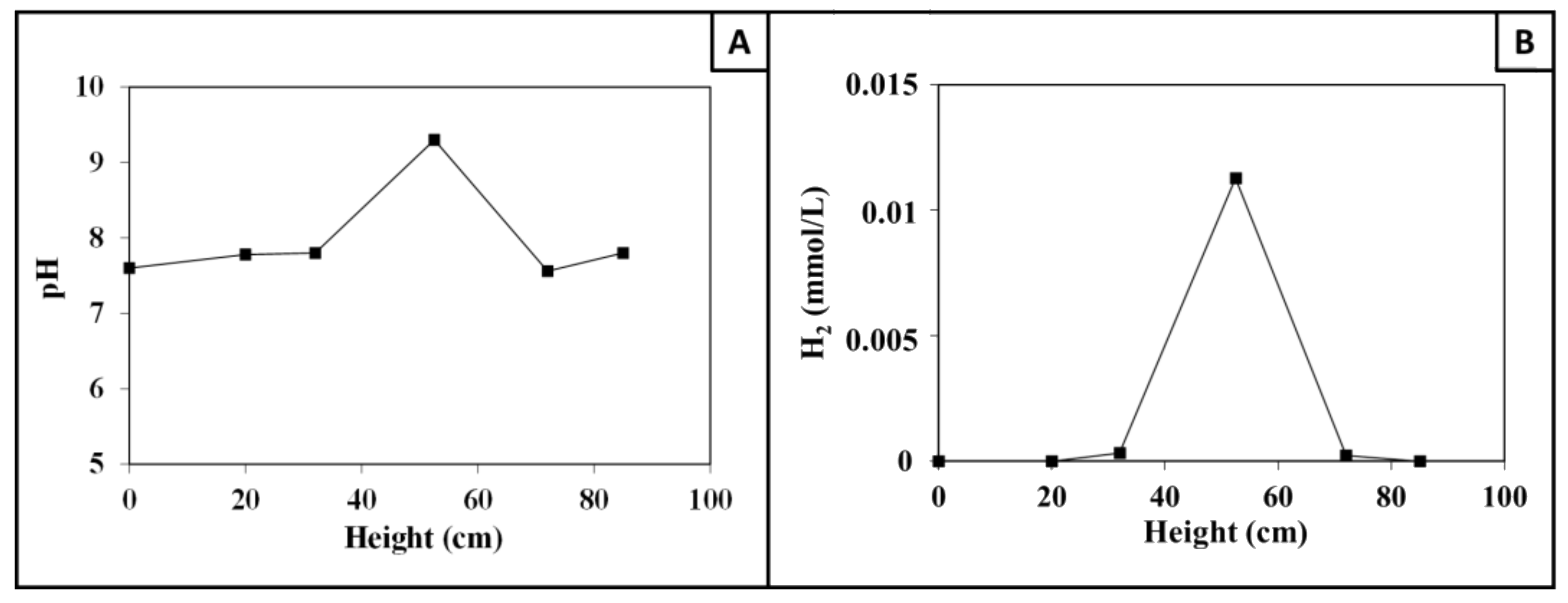
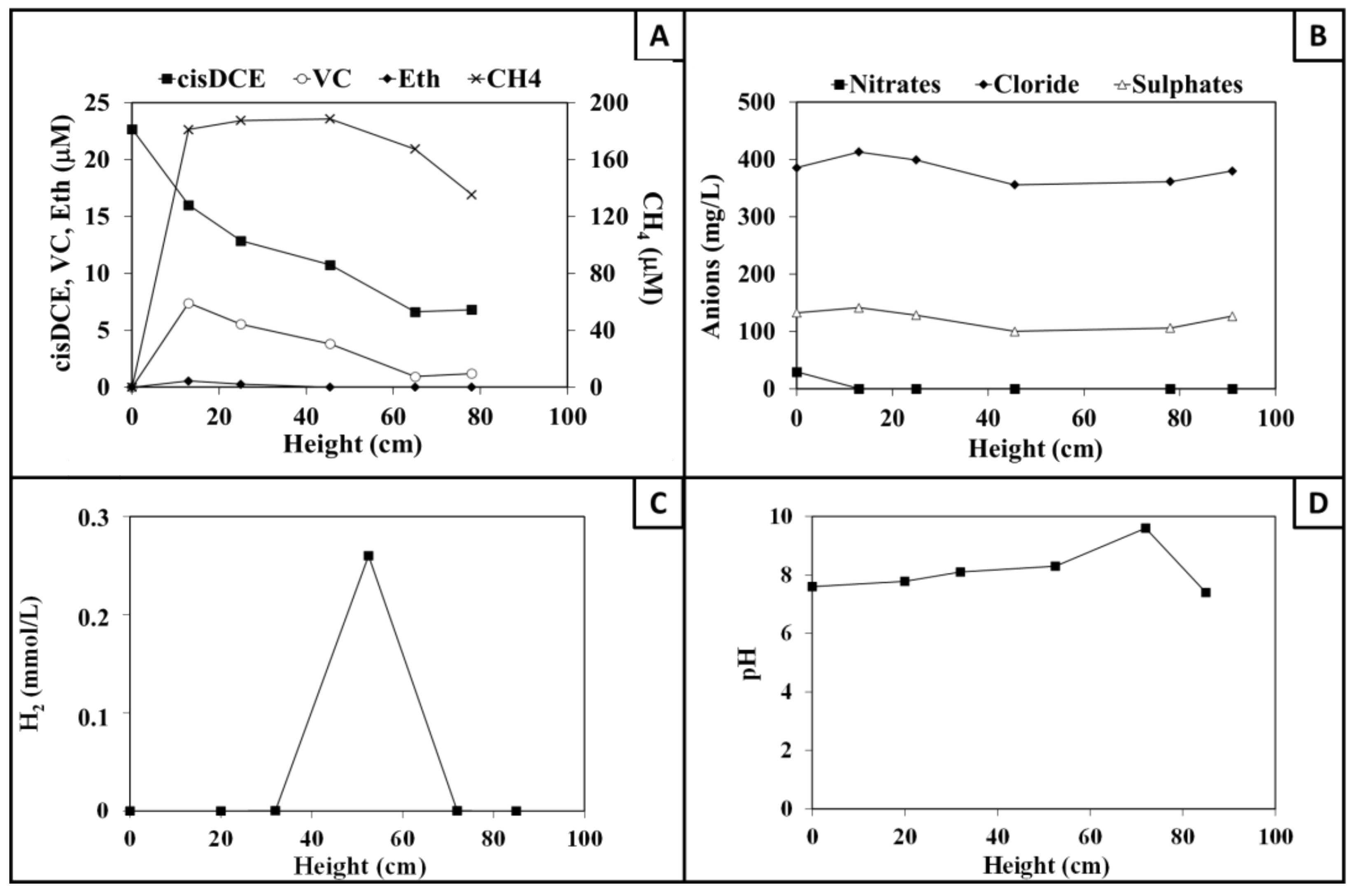
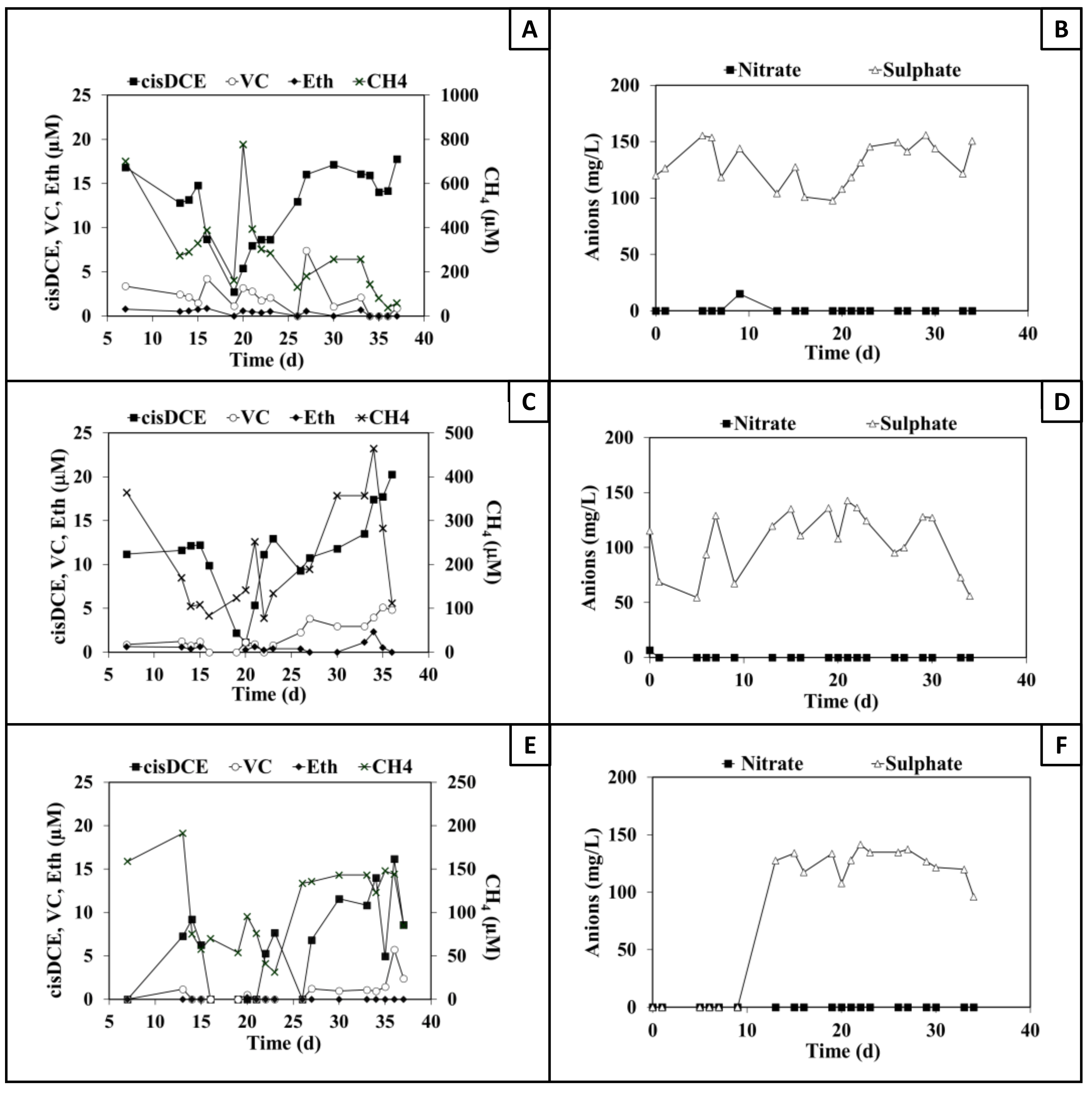

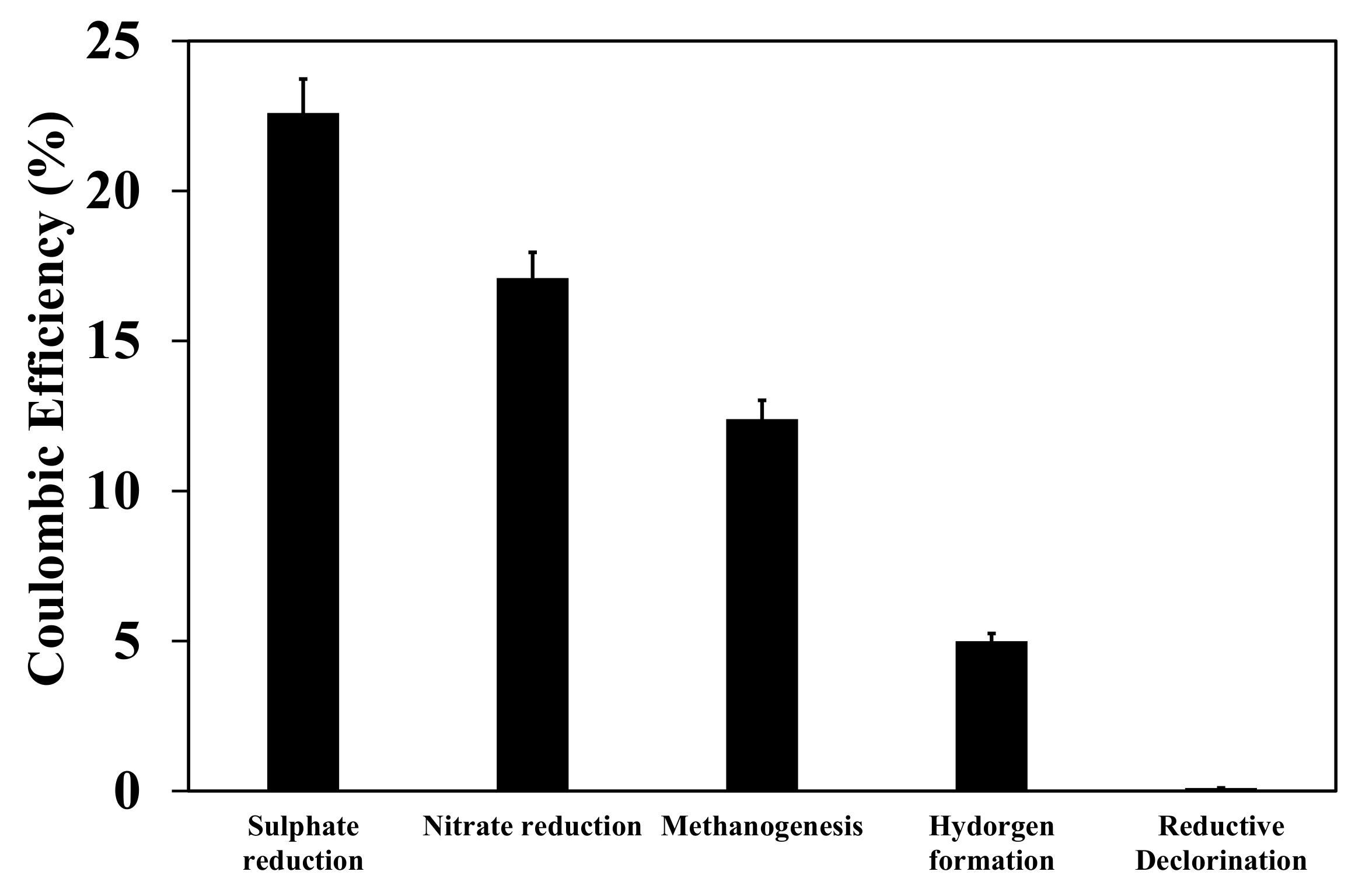
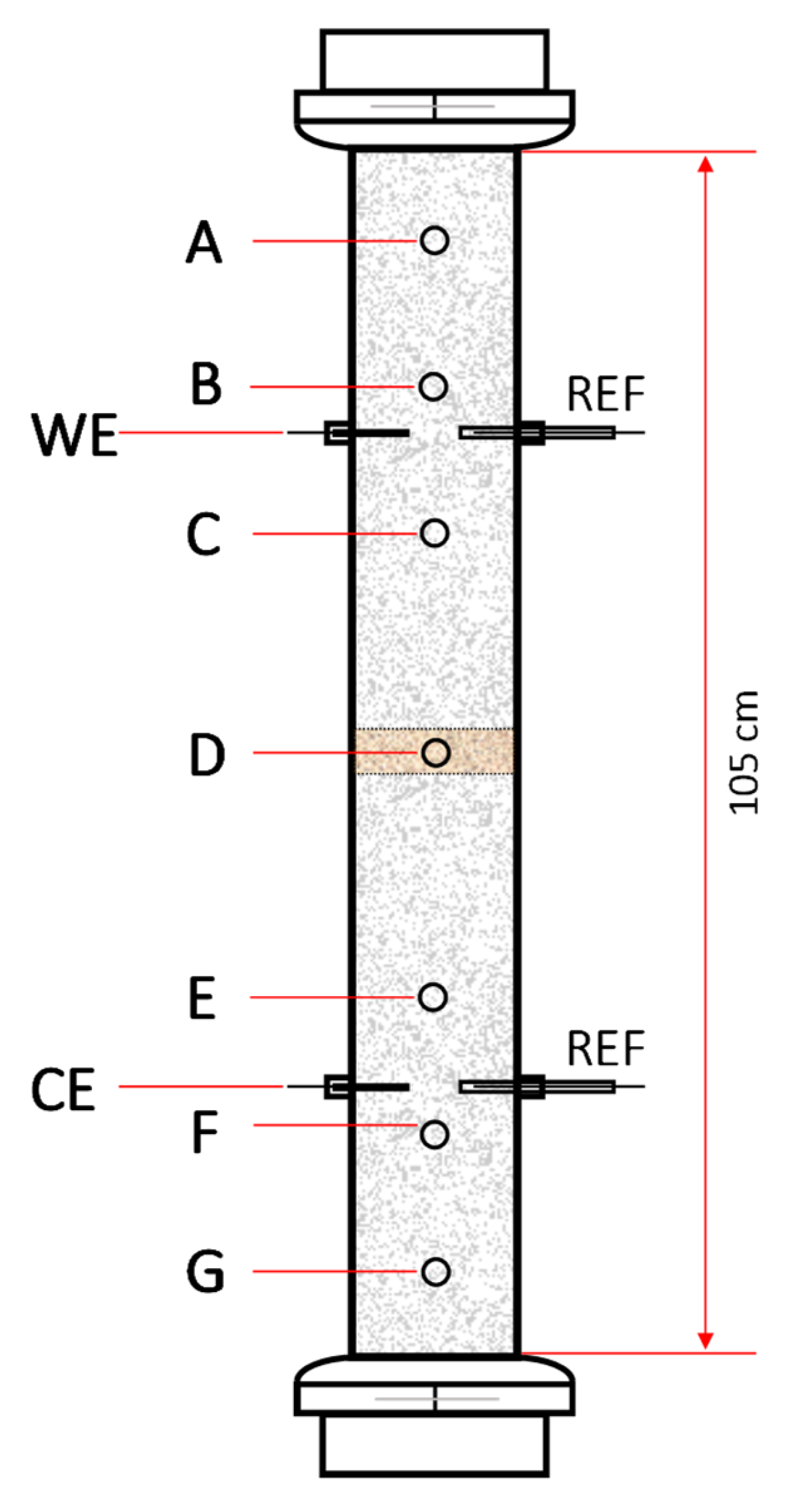
| μmol/L | μg/L | (CSC) μg/L | |
|---|---|---|---|
| VC | 0.34 ± 0.10 | 21.1 | 0.5 |
| cisDCE | 0.98 ± 0.12 | 61.1 | 60 |
| TCE | 0.59 ± 0.3 | 77.3 | 1.5 |
| PCE | 0.09 ± 0.01 | 15.2 | 1.1 |
| Chloride | 800 ± 16 | 2910 ± 31 | |
| Nitrate | 400 ± 21 | 2630 ± 40 | |
| Sulphate | 2013 ± 40 | 1895 ± 210 | 2500 |
| PRB | Internal Counter-Electrode [35] | |
|---|---|---|
| HRT (d−1) | 0.8 | 1.2 |
| RD (meq/Ld) | 20 ± 11 | 134 ± 11 |
| CE RD (%) | 0.1 ± 0.1 | 2.1 ± 0.5 |
| CE NO3−(%) | 17 ± 2 | 12 ± 4 |
| CE SO4−2(%) | 22 ± 4 | 89 ± 7 |
| Energy consumption (kWh/m3) | 4.6 ± 0.9 | 0.6 ± 0.1 |
Disclaimer/Publisher’s Note: The statements, opinions and data contained in all publications are solely those of the individual author(s) and contributor(s) and not of MDPI and/or the editor(s). MDPI and/or the editor(s) disclaim responsibility for any injury to people or property resulting from any ideas, methods, instructions or products referred to in the content. |
© 2024 by the authors. Licensee MDPI, Basel, Switzerland. This article is an open access article distributed under the terms and conditions of the Creative Commons Attribution (CC BY) license (https://creativecommons.org/licenses/by/4.0/).
Share and Cite
Sassetto, G.; Lorini, L.; Lai, A.; Petrangeli Papini, M.; Zeppilli, M. Groundwater Bioremediation through Reductive Dechlorination in a Permeable Bioelectrochemical Reactor. Catalysts 2024, 14, 208. https://doi.org/10.3390/catal14030208
Sassetto G, Lorini L, Lai A, Petrangeli Papini M, Zeppilli M. Groundwater Bioremediation through Reductive Dechlorination in a Permeable Bioelectrochemical Reactor. Catalysts. 2024; 14(3):208. https://doi.org/10.3390/catal14030208
Chicago/Turabian StyleSassetto, Geremia, Laura Lorini, Agnese Lai, Marco Petrangeli Papini, and Marco Zeppilli. 2024. "Groundwater Bioremediation through Reductive Dechlorination in a Permeable Bioelectrochemical Reactor" Catalysts 14, no. 3: 208. https://doi.org/10.3390/catal14030208
APA StyleSassetto, G., Lorini, L., Lai, A., Petrangeli Papini, M., & Zeppilli, M. (2024). Groundwater Bioremediation through Reductive Dechlorination in a Permeable Bioelectrochemical Reactor. Catalysts, 14(3), 208. https://doi.org/10.3390/catal14030208








